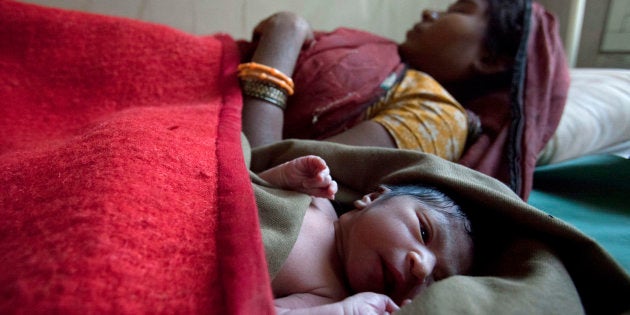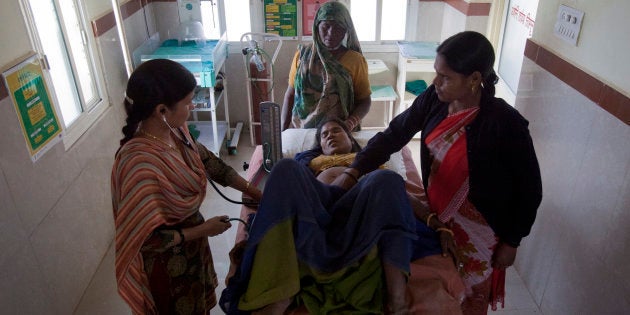
As a 10-year-old little girl, 32 weeks pregnant with her alleged rapist's child, prepares to deliver the baby in Chandigarh, little does she know that her tragic circumstances have rekindled the longstanding abortion debate in the country.
Last week, the Supreme Court denied her plea to terminate the pregnancy. Close on her heels was the case of another victim, a 14-year-old mother from UP who made headlines when news broke that extreme poverty forced her to marry the man who admitted to raping her just so she could feed the child born out of her abuse.
As disheartening as every story of rape is, these two cases have more in common than that. They shed light on the broken legal system in the country and the repercussions it has on the future of the young girls, who, already suffering from the trauma of rape, are forced to carry to term the pregnancies resulting from them.
These cases also raise important questions about the legally permissible limit of 20 weeks for abortion under the Medical Termination of Pregnancy (MTP) Act, 1971, the relevance of the Act in today's world and the urgent need for amendments to it.

The failure of the law
In its current form, the MTP Act permits abortion after consultation with one doctor upto 12 weeks. Between 12 to 20 weeks, a woman seeking abortion needs the medical opinion of at least two doctors. Exceptions are made to the 20-week ceiling if continuing the pregnancy poses a threat to either the mother or the baby's life, but only after approval from courts.
It is admirable that India was one of the first countries in the world to legalise abortion to encourage family planning and population control. Ostensibly, the reason for the relatively low time frame was to safeguard the girl child by preventing sex-selective abortions. While that is a noble intent, women who discover abnormalities in the foetus or develop complications later in their pregnancies, and rape victims, particularly underage ones, end up bearing the brunt of it.
The court was forced to note that due to advancements in medical technology, pre-natal defects could be revealed even after 20 weeks.
And because the MTP Act is outdated and doesn't consider these eventualities, women are forced to move court. Consequently, judgements that are doled out vary drastically due to individual interpretations of law.
In July this year, a Kolkata woman was allowed to terminate her 26-week pregnancy by the Supreme Court because the foetus suffered from cardiac ailments. In January, it allowed a Mumbai woman to terminate her 24-week pregnancy because the foetus was suffering from anencephaly (a condition in which it can survive only inside the uterus). But in February, the same Supreme Court refused a woman's plea to abort a 26-week-old foetus that would be born with Down syndrome, as they admitted that the child may suffer from severe abnormalities.
Similarly, in 2008, when a couple petitioned the Bombay High Court to abort at 26 weeks when the foetus was diagnosed with a heart defect, they were turned down. This was among the first cases in which the court was forced to note that due to advancements in medical technology, pre-natal defects could be revealed even after 20 weeks, and that perhaps it was time to re-evaluate MTP.
It is worth mentioning that the girl's family lost a precious 8 weeks in the long-drawn-out legal proceedings.
Another thing that the law fails to take into account is that often, especially in the case of underage rape victims, pregnancies are discovered very late. Due to the stigma attached to rape and the silence of the victims, underage pregnancies are often only discovered when the child develops health issues and medical intervention is finally sought. In many cases, by the time they come to light, the child is either teetering very close to the 20-week mark or has already crossed it. As a result, there are a slew of cases with young girls and women pleading before courts to allow them to terminate unwanted or unviable pregnancies that are over 20 weeks.
In the case of the 14-year-old girl from UP, 'advanced pregnancy' (32 to 33 weeks) was the court's reason for denying permission to abort. However, it is worth mentioning that the girl's family lost a precious 8 weeks in the long-drawn-out legal proceedings. Today, her extenuating financial circumstances that have made it impossible for her family to support her and the baby, coupled with their ostracisation from society, have forced her to marry her rapist. All of this could have been avoided, had the law worked in favour of the victim, instead of against her.
All these incidents make it evident that unless alternate provisions are made, courts will continue to be forced to evaluate and rule on individual cases. This might work as a stop-gap arrangement, but is obviously not a feasible solution to the problem in the long term.

Slow legal machinery
Despite these significant oversights in the law, they are just one part of the problem. The issue is further complicated when our grindingly slow legal machinery makes it medically dangerous to safely terminate the pregnancy, rendering the whole process of seeking legal intervention an exercise in futility.
In January, a 35-year-old HIV+ woman from Bihar was forced to have a baby because her paperwork got stuck at a government hospital for 4 weeks and she crossed the 20-week mark. A long legal battle ensued, which ended with both Bihar's high court and the Supreme Court rejecting her abortion plea in May. The reason: she was already 26 weeks pregnant by then and abortion was a risky proposition.

What's the solution?
Clearly, the law is currently at cross-purposes with the need of the hour. While its original objective was to prevent sex-selective abortion, that line of reasoning no longer holds true since medical advancements have made it possible to determine the sex of the baby as early as 10 to 12 weeks through chorionic villus sampling (CVS), between 15 and 20 weeks through amniocentesis, and at 7 weeks, through a new blood test that has fast gained popularity among medical practitioners in Europe, since findings were published in 2011 in The Journal of the American Medical Association.
Another commonly used argument against increasing the legal limit for abortion is the baby's right to life. At what point does the foetus become a baby, or a sentient being. Unfortunately, there is no one universally acceptable answer.
While opinions range from right from the time of conception (pro-lifers) to the time when the foetus becomes viable (able to survive outside the time of birth) to the time of birth, there is no one benchmark that is globally used to frame their laws.
By making abortion a qualified right, the law does not recognise women as individuals with autonomy over their own bodies, a glaring mistake by all accounts.
Each country has its own arbitrary laws that are more influenced by religious and moral beliefs than science. While on the one hand there are countries like Chile and Vatican City that do not allow abortions for any reason, there are those like France, Germany, Greece and Russia, that allow abortion for any reason, usually up to 20 weeks. 58 of the 196 countries in the world provide abortions on request, and 134 countries only allow abortions to preserve a woman's health.
India, despite its liberal abortion law, does not compute 'choice' as a factor for abortion. A lesser-known fact about the MTP Act is that a woman cannot simply choose not to be a mother; abortions are conditional and predicated on reasons like the physical or mental health of the mother, a potentially handicapped or malformed child, rape, underage pregnancies, pregnancies in women of reduced mental capability and failure of contraception. By making abortion a qualified right, the law does not recognise women as individuals with autonomy over their own bodies, a glaring mistake by all accounts.
Even so, it is commendable that India's abortion law from 46 years ago is more liberal than the laws of many countries even today. More admirably, it is a secular law; it does not pander to any religion's beliefs about when life starts and the foetus' right to life. At the time of enactment, it was practical, and it truly served the best interests of the mother.
Which is why, in keeping with the spirit of the thought behind the original law, it now needs to be amended.
"It is an old law, that needs to be reviewed and strengthened," says Dr Rishma Dhillon Pai, president of the Federation of Obstetric and Gynaecological Societies of India (FOGSI), a body representing 34,000 gynaecologists in the country. "There is greater focus on the time frame than what needs to be done in the best interest of the mother and the baby. You can't say that abortion is safe at 19-and-a-half weeks, but unsafe at 20-and-a-half weeks."
It is unconscionable that women who are already suffering have to then get embroiled in a legal wrangle.
Dr Duru Shah, who has, in the past, served as the president of FOGSI and as a member on the ethics committee of the International Federation of Gynecology and Obstetrics (FIGO), agrees. "The limit definitely needs to be extended to 24 weeks, because medical advancements have ensured that it is perfectly safe and ethically sound to terminate pregnancies at that stage."
While Dr Pai admits that abortions are safer now until much later, FOGSI's recommendations for amendments to the MTP Act do not specify a time period to which terminations should be legally permissible, recommending instead, that the law be amended to give medical practitioners more liberty to do what's best in a given situation. "Today, certain foetal abnormalities, particularly cardiac and brain anomalies, are only detected beyond 20 weeks. Sometimes, the foetus is unviable or incompatible with life. It is unconscionable that these women, who are already suffering, have to then get embroiled in a legal wrangle. If multiple qualified doctors are of the opinion that termination is the best option, that should be enough," she says.
According to Dr Shah, in addition to extending the time limit, the law also needs to be changed to provide better recourse for cases that fall beyond its scope. "There needs to be one national committee of medical experts that reviews exceptional cases and rules on it," she says, as an alternative to the hassle of filing cases and moving court, which results in further delays and complications.
In the case of the 10-year-old girl, she is being denied pregnancy citing medical risks. That is not true. The bigger the baby grows, the more the risk to the girl.
Both doctors agree that more emphasis needs to be placed on medical advancements while framing policies to regulate termination of pregnancies.
"Viability of the foetus is an important marker while making laws, but as science progresses, the time frame for viability will become lesser and lesser," says Dr Pai. "When it comes to termination, viability is really not even the point. It is about doing what's best for the mother and the baby. There are so many advancements in science that pregnancies can be terminated without harming the mother. That needs to be considered."
Adopting a medically sound, humanitarian approach is more important than strictly following the letter of the law, in Dr Shah's opinion. "In the case of the 10-year-old girl, she is being denied pregnancy citing medical risks. But the bigger the baby grows, the more the risk to the girl. Today, there are so many procedures and drugs that can be used to safely terminate the pregnancy. It is very unjust to her," she says.

The legal journey
In light of the rising number of pleas for abortion beyond 20 weeks being heard by courts across the country, there have been several calls for changes in the MTP Act in the past.
In October 2014, the Ministry of Health and Family Welfare released a draft of the MTP (Amendment) Bill, based on the findings of a project undertaken by the Population Council of India between 2006 and 2011 and the recommendations of the National Commission of Women in 2013.
The Bill proposed several changes to the existing law in keeping with the times, such as: increasing the legal limit for abortion from 20 to 24 weeks, eliminating the need for a second medical opinion in the case of a second trimester abortion, recognising that the right to safe and legal abortions is every woman's right, not only that of sexually active married women (as per the existing MTP Act) and allowing non-allopathic healthcare providers such as midwives, nurses, homeopaths, etc. to perform non-invasive early-stage abortions.
Of the 6.4 million annual abortions in the country, 3.6 million or 56 per cent are unsafe.
While the recommendation to allow non-allopathic doctors to perform abortions was criticised by several medical bodies, including the Indian Medical Association (IMA), there were many good things about the proposed law. The aim behind the recommendation to include non-allopathic practitioners was to reduce the dependency of women on clinical doctors and their individual interpretation of the law and to prevent financial exploitation of these women by monopolising abortions.
In addition to empowering women, one of the core objectives of the Bill was to reduce the number of unsafe abortions in the country. According to the Abortion Assessment Project, one of the largest studies on abortion ever undertaken in India which lasted from 2000 to 2004, of the 6.4 million annual abortions in the country, 3.6 million or 56 per cent were unsafe. Deaths from unsafe abortion are the cause of 10 to 13 percent of maternal deaths in India.
The PMO returned the draft to the health ministry and asked it to strengthen the existing MTP and Pre Conception-Pre Natal Diagnostic Techniques (PC-PNDT) Acts.
The proposed amendments also recognised a woman's right to choose, even though that was restricted to the first trimester. Another great thing was that by removing the 'married women' qualifier, it empowered single and unmarried women who needed the procedure.
Unfortunately, the MTP Amendment Bill is still not a reality. In March this year, the Bill was submitted to the Cabinet for its approval. In May, the Prime Minister's Office returned the draft to the health ministry and asked it to, instead, strengthen the existing MTP Act and Pre Conception-Pre Natal Diagnostic Techniques (PC-PNDT) Act (meant to crack down on sex-selective abortions).
And so, in the absence of a modern, amended version of the MTP Act, aggrieved women continue to flock to the courts seeking relief while courts across the country are burdened with the responsibility of reviewing and ruling on each case individually.
If this isn't a travesty of justice, what is?